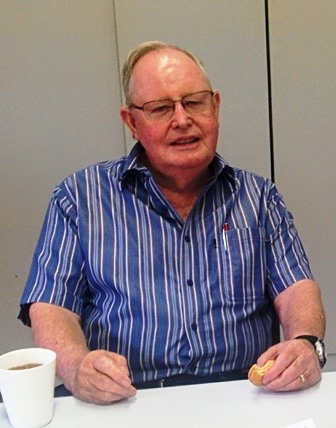When I knocked off at 2 p.m , I would, on my way home, call into St.Joseph’s church for a quick visit. One day I found the cloth on the altar had been set alight. I was there! The altar was constructed of marble and the surrounds were all tiles, so there was no chance of the fire spreading. I promptly extinguished the fire and went to the Presbytery, or the Parish House as it is now known, to advise the clergy. There were then three priests sharing control of the parish, a change from the old fashioned Monsignor O’Rielly who ruled the parish on his own. None of the priests were present; Kate McCormack was there voluntarily painting the interior of one of the rooms. I suggested to her that she should advise the priests, who I expected to contact the police.
The next day, when I was on my way to the church, I noticed a large black cloud of smoke billowing from the church in front of me. The arsonist had struck again! The whole church was alight! It took some time, but even with the attendance of the town’s volunteer fire brigade, the church was completely gutted. Miraculously, the stained glass window behind the altar was unharmed, but the church itself was nothing but a shell.
There was great consternation among the clergy and the parishioners, and a restructuring committee was quickly formed under the guidance of Greg Dore as chairman. Jim Smith, my business partner, anxious to raise quick funds, suggested an auction of 20 numbered certificates bearing a photo of the church and appropriate wording. The auction was soon held with John Boyd acting as auctioneer. With a large crowd in attendance the NO 1 certificate was purchased by the St.Joseph’s cricket club for a handy sum. The NO 2 certificate was purchased by Bernadette and myself for a sum in excess of $300. A considerable amount was raised.
The insurance company paid for a large part of the restructure, but there was a short fall. Consequently the pipe organ , which had cost many thousand dollars, was not replaced, and the slate tile roof was replaced by colorbond, a fact which riled a number of parishioners. Because of the short fall, there was still need for an appeal, which quickly made up the difference. In times of need parishioners were particularly generous.
The church was unavailable for the conduct of services for many months and the Anglican Church , in a generous euchaminical gesture, allowed the Catholics to use Holy Trinity Church on significant occasions, such as weddings and funerals. For our regular Sunday Masses the St.Joseph’s School hall was used.
Ray O'Shannessy
May 16, 2017


 RSS Feed
RSS Feed
